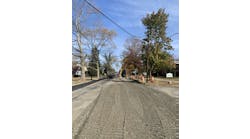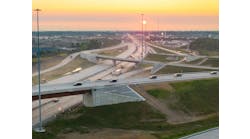By Harlee Hewitt, Associate Editor
What was once a high-risk intersection plagued by frequent crashes, including fatal ones, has now become a model of traffic safety.
The implementation of the Restricted Crossing U-Turn (RCUT) intersection at U.S. Highway 68 and Kentucky Highway 139 in Trigg County, Ky. has significantly reduced crashes, injuries and fatalities, by improving safety and traffic flow.
Before the RCUT’s implementation, the intersection had a troubling history of crashes and fatalities. Data collected from the four years before construction of the Trigg County RCUT showed 16 crashes, seven injuries and two fatalities, with an additional fatal crash occurring just before the project began.
In contrast, crash data from Dec. 15, 2020, to Dec. 15, 2024, demonstrates a stark improvement: only six crashes, two injuries, and no fatalities.
Kyle Poat, Kentucky Transportation Cabinet (KYTC) District 1 chief engineer, described the RCUT as having substantial impact on the region.
“If you do the math, police crash reports show we’ve had a 64.5% decrease in total crashes since the RCUT was completed and a 71% decrease in injuries,” Poat said. “The greatest success is that no lives have been lost since the RCUT opened.”
The success of the intersection has extended beyond roadway safety. Trigg County Emergency Management Director David Bryant said the intersection has also reduced strain on emergency services.
“The RCUT has almost eliminated our emergency calls to that location, meaning less demand on our call-center personnel and fewer callouts for the responding agencies,” he said.
History of a Problematic Intersection
The significant reduction in fatalities underscores the long-standing safety challenges at the intersection, which have been a concern for decades.
The original intersection was originally constructed in the mid-1990s as a two-lane road. However, issues with collisions had been recorded since the early 2000s.
In response, KYTC expanded it to a four-lane corridor in 2016 and added flashing beacons and improved sight distances. But crashes persisted.
As public concerns grew, local officials advocated for a traffic signal at the intersection. However, KYTC engineers determined that a signal would not effectively address the safety concerns and could even increase severe T-bone collisions at high speeds.
“The problem with a signalized intersection in a high-speed corridor is that it increases the risk of severe T-bone crashes,” Poat said. “With the RCUT, we immediately cut the number of conflict points in half, and the remaining ones are typically glancing impacts or rear-end collisions, which are far less severe.”
How It Prevents Crashes
RCUTs are designed to minimize conflict points—locations where vehicles cross paths—thereby reducing the likelihood of severe collisions. Traditional four-way intersections have 32 potential conflict points, whereas an RCUT reduces these to 16.
Moreover, RCUTs eliminate direct left turns from side streets, requiring vehicles to first turn right before making a U-turn at a designated crossover. This setup forces drivers to focus on only one direction of traffic at a time, simplifying decision-making and reducing high-impact crashes.
“What you do is reduce how many decisions a driver has to make,” Poat said. “Instead of worrying about traffic coming from both directions and across from them, they only need to look for an opening in one direction before making their turn.”
This simplification makes intersections safer, especially for less experienced or distracted drivers who might otherwise struggle with traditional four-way stops. By guiding traffic in a structured manner, RCUTs help prevent the most dangerous types of accidents.
KYTC studied RCUT implementations in other states, including North Carolina, Missouri and Michigan, before deciding to implement the design in Kentucky. Nationally, RCUTs have been shown to reduce crashes by an average of 54%, according to Poat.
Given the positive results seen elsewhere, KYTC opted to install its first RCUT in Trigg County, rather than adding a traffic signal. After installation, Poat and KYTC discovered that the RCUT was appreciated by the community.
“What we found is that once people experience the RCUT, they quickly see the benefits,” he said. “At first, there was hesitation, but once the data came in and people started driving through it, they understood why we made the decision.”
For such significant reductions in risk, RCUTs take a relatively short time to turn around. The RCUT in Trigg County took about six months of design work before moving into a nine-month construction phase.
KYTC used drone technology for surveying and incorporated lessons from previous RCUT projects in the state to refine the design, reducing future construction times.
“As we’ve refined the RCUT design, we’ve created a more standardized approach that we can implement more efficiently,” Poat said. “We now have almost a cookie-cutter method for these intersections, which will speed up future projects.”
The use of drone technology allowed precise measurements and faster adjustments to the design, minimizing disruptions and ensuring accuracy. Engineers could overlay previous successful designs onto new project sites, tweaking them as necessary based on the specific roadway requirements such as the type of vehicles that frequent the roadway or the space allotted.
Commitment to Safety
The success of the Trigg County RCUT has led KYTC to expand its use of safer intersection designs. Currently, District 1 has 12 RCUTs in operation, with four more in the design phase and another four in the planning pipeline. Additionally, the state is increasing its use of roundabouts and diverging diamond interchanges to enhance roadway safety.
“Across Kentucky, we are shifting toward intersection designs that reduce severe crashes and improve traffic flow,” Poat said. “We’ve seen the data, and it proves that these solutions work.”
RCUTs and roundabouts, in particular, are being prioritized because they maintain the flow of traffic while reducing the potential for deadly collisions. Unlike traditional signalized intersections, these designs keep vehicles moving, which also reduces congestion and improves travel times.
KYTC plans to analyze crash data from recently constructed RCUTs across multiple counties, including Graves, McCracken and Marshall, to evaluate their effectiveness. Poat said early indicators suggest that the positive trends seen in Trigg County are being replicated in these locations as well.
“With 11 more RCUTs constructed across six counties, we’re excited to soon have enough data to measure their full impact,” he said. “We anticipate similar, if not better, safety improvements at these locations.”
Looking further into the future, KYTC is considering incorporating even more advanced technology into intersection design, including smart traffic monitoring systems that could help optimize flow in real-time.
“As technology continues to evolve, we want to integrate more real-time data into our road designs,” Poat said. “This could mean using sensors to detect traffic patterns and adjust the RCUT functionality accordingly.”
As Kentucky continues prioritizing road safety, the RCUT model stands as a testament to innovative engineering that saves lives.
“At the end of the day, reducing crashes and preventing fatalities is what matters,” Poat said. “And the numbers speak for themselves.” RB



